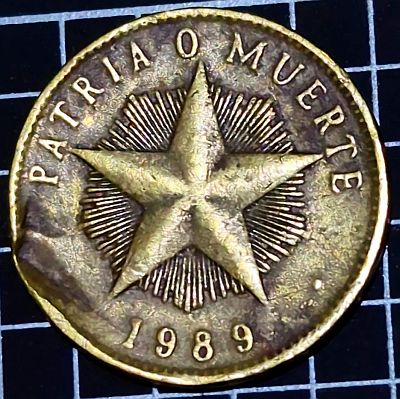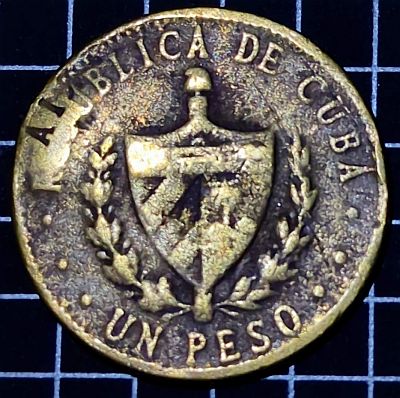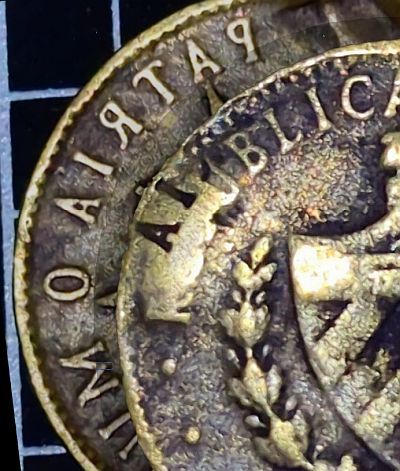Interesting damage to this coin from Communist Cuba
Cuba 1920s-1980s
When we covered the 1920 5 Centavos, we also covered the history of Cuba to that time. Let’s pick up in the 1920s. Gerardo Machado y Morales became president in 1925. His rule has been described as “Cruel Dictatorship”. On top of the economic hardships of global Depression, several small army revolts saw him flee the country in 1933. Sergeant Fulgencio Batista y Zaldívar then joined forces with militant students to overthrow the U.S. backed regime. Although intending to force change, Batista took power himself, first through force, then through elections (1940).
Following the first Batista era in WWII, Cuba experienced several peaceful, democratic governments, and relative prosperity. In 1952, Batista led another coup d’état during which much of Cuban government and society collapsed into civil war. On the first day of 1959, Fidel Castro Ruz, a charismatic, anti-U.S. revolutionary, seized power from the US-backed Batista government. Castro expropriated U.S. properties in Cuba and converted the country into a single-party communist system. The United States imposed an embargo on Cuba in 1960. Two CIA-sponsored invasions of Cuba in 1961 by Cuban exiles were defeated, a huge propaganda win for Castro.
Tensions between the countries peaked in 1962 with the “Cuban Missile Crisis” once Soviet-backed missiles were revealed in Cuba. Following a full US naval blockade, the missiles were removed, and tensions eased, though relations did not improve. Cuba’s alliance with the Soviets gave Castro access to military assets to achieve his foreign aims. These included supporting guerrilla groups in Latin America, and overthrowing regimes in Angola and Nicaragua. Some of these were reversed in the 1980s, showing the limits of Castro’s influence.
Reverse

The reverse of the coin, issued from 1983 – 1989, harks back to the original silver 1 Peso coin of 1916 – 1934. (There had been a slightly earlier gold coin of a different design which was issued in limited quantities in 1915-1916).
The design features a five-pointed star with rays, as the main element. The motto “Patria O Muerte”, meaning “Fatherland or Death” on top with date below. Note that the motto has changed from the “Patria y Libertad” (Fatherland and Freedom) seen on the earlier 1920 coin.
Obverse

The obverse is similar to that of most Cuban coins. It features the coat-of-arms in the centre, country name above, and the value, “Un Peso” written below.
Impact damage
This particular coin has some interesting damage. Coins are carried everywhere and dropped in all kinds of places, so damage is not uncommon. One thing I love about collecting circulated coins is that this is one factor taken into account when designing them. Coins need to be specific sizes and often metals to work with vending machines. They need to be made of a robust metal, with a design which won’t easily wear off. Where Non-Circulated Legal-Tender (NCLT) coins can basically be any shape or design, circulating coins have a lot more constraint. With this particular coin, the damage is quite interesting. Initially I thought the coin had been counterstamped, such as was (officially) done on this Brazilian coin. In this case, looking closer, and thanks to members of a counterstamped coins group, gives more information. What has actually happened is that the coin has likely been stacked with other Un Peso coins when they have been struck by something with such force that the design from one has been impressed on the other. In this case, the A which is clearly visible is the end of the word “PATRIA”. The I to its right (the word is reversed) and the right part of the letter R. Here is the other side of the coin, reversed and rotated to show what the design would look like if it was fully stamped onto this coin:

The Un Peso coin has “Coin” orientation. That is if you hold the coin by the left and right sides, and flip (top to bottom), the design on the other side stays right way up. Therefore looking at the reverse image of the coin, you can see the damage on the lower-left, and on the obverse image, the impressed letters on the top-left.
While this is known as “Post Mint Damage” (PMD) or simply damage, and takes away, rather than adds value to a coin, they can still be interesting pieces. What is your most interesting, damaged coin? Share in the comments or on social media.


Leave a Reply